|
E. C. &
J. Keay Limited was founded in 1879 at New Street,
Birmingham by Ernest Charles Keay and his brother James
Keay. They were builders and ironmongers. In 1884 they
moved to Cyclops Works, West Bromwich and began to
manufacture fencing, fittings, and steel fabrications.
The site that would eventually be occupied by the
company at James Bridge, originally belonged to Samuel
Mills, the wealthy industrialist and land owner who ran
Bills and Mills ironworks at The Green. After his death
in 1864 much of his land was sold-off by his executors,
Richard Mills, Martha Mills, and James Slater.
In January 1870, just over an acre
of land alongside James Bridge Railway Station and
Walsall Road was purchased for £150 from the executors
by Simeon Carter, who three years later formed his own
firm, Carter, Ford & Company Limited, manufacturers of
wrought-iron bridges, girders, roofing, railway
ironwork, and cab axles etc. The firm opened James
Bridge Ironworks on the site, but only had a relatively
short life, going into liquidation in September 1886.
|

A Keay builder's plate.
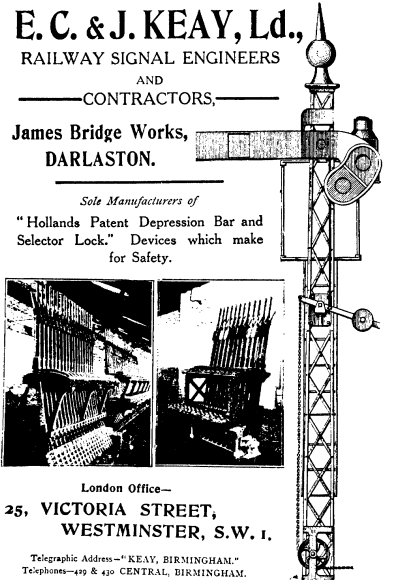 |
In December of that year, the company's property and
assets were put up for sale, and in January 1887 were
acquired by the Keay brothers.
In 1887 Keays moved to
"Bridge Yard", as they called the James Bridge site, and
in June 1888 they purchased an adjacent three acres of
land from Martha Mills and James Slater, along with a
strip of land on the opposite side of Heath Road.
Originally there were no buildings, only open gantries.
E. C. & J. Keay was
incorporated in 1893, and listed in the 1896/1897 Peck's
Trades Directory of Birmingham as makers of steam
boilers. By 1898 the whole business had moved to James
Bridge, and within twelve months the firm added an iron foundry
to the site for the production of bearings and cast
ironwork.
The firm produced many products over the
years, eventually specialising in structural steelwork
for all types of buildings, such as schools, hospitals,
factories, offices, and warehouses. Bridge Yard had three large
open shops, and good access to the railway, nearby
ironworks and rolling mills. |
|
Machines included saws, angle
croppers, punches, shears, guillotines, presses,
planers, drilling machines, bending rolls, riveting
machines, and welding machines. In fact everything
needed for the production of structural steelwork. There
were facilities for the trial erection of complicated
structures, and ample storage space for finished
materials so that deliveries of steel could be phased to
suit erection.
For erection purposes there were
electric scotch derricks, hand cranes, derricks and
winches, mobile cranes, and electric compressors to
provide power on site. Keays undertook the complete
design, fabrication and erection of their structures.
|
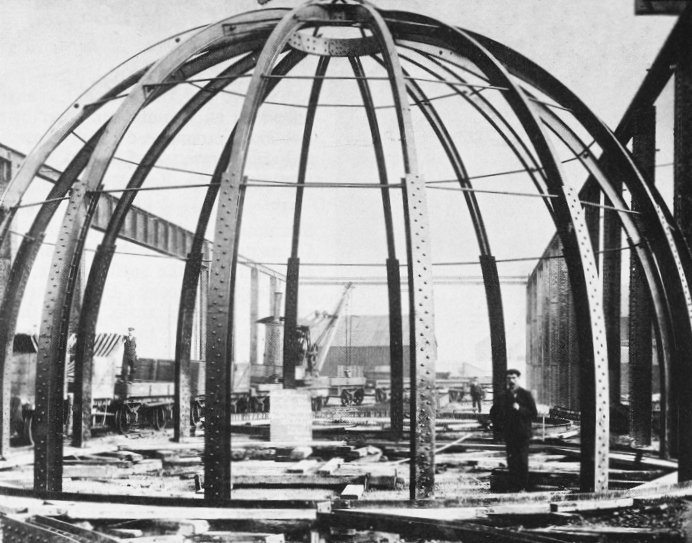
One of the firm's many jobs
before the First World War was the structural steelwork
for the dome of the Victoria and Albert Museum, seen
here at the factory in 1905. Courtesy of Wendy Marston. |
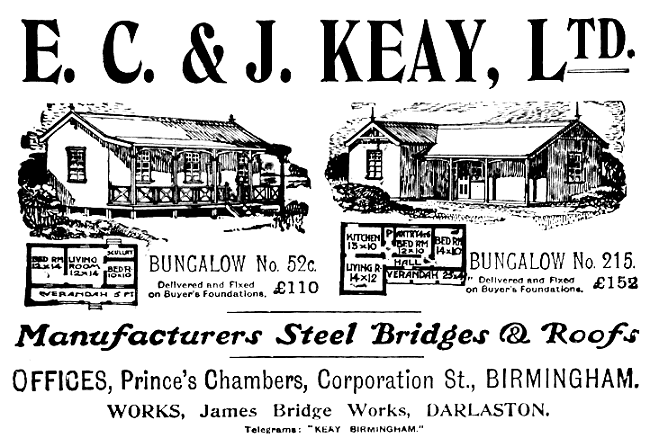 An advert from 1912.
An advert from 1912.
|
Mr.
James Keay's obituary in the Birmingham
Post, 14th December, 1920. Courtesy of
Peter J. Carter.
The death took
place suddenly at his residence, The
Cedars, Great Barr, on Sunday, of Mr.
James Keay, a director of the firm of
Messrs. E. C. and J. Keay Limited,
bridge builders and engineers of
Darlaston, Birmingham, and London.
Mr. Keay, who was
68 years of age, was also concerned with
other commercial interests in the
Midlands, being a director of Messrs.
Thomas Perry and Company, engineers of
Bilston, and of the Cannock and Leacroft
Colliery Company. A member of the Perry
Barr District Council, he at one time
held the position as chairman of that
body, and he was a member of the
committee of the Orthopaedic Hospital.
Mr. Keay took a keen interest in matters
relating to church life, being a member
of the Catholic Council and also
associating himself with the Bishop of
Birmingham Fund. |
|
| Mr. Ernest Charles Keay's
obituary in the Birmingham Post, 18th
April, 1932. Courtesy of Peter J.
Carter. Mr.
E. C. Keay, a leading figure in Midland
industrial and financial circles, died
this morning at his residence, 28
Westfield Road, Edgbaston. Mr. Keay, who
was in his 80th year, had been confined
to bed for about two weeks, following a
recurrence of an illness which
incapacitated him about twelve months
ago.
Mr. Keay was the
son of a former South Staffordshire
ironmaster, James Keay. He was educated
at Leamington and spent his early years
at Great Barr, where his father lived.
When still in his teens, the
responsibility of taking charge of a by
no means inconsiderable business at West
Bromwich fell on his shoulders. Rapidly
maturing however, the young man quickly
developed his business instincts and
extended the activities of the firm to
Darlaston, where he went into
partnership with his elder brother, the
late Mr. James Keay. There the two
brothers acquired the works of Carter,
Ford and Company and developed the
branch of constructional steelwork with
which the firm of E. C. and J. Keay
Limited is so closely concerned.
Important Contract
From its beginnings
the firm was responsible for a number of
large and important contracts including
the roofing of London rail termini, dock
sheds in Liverpool, South Wales and
Portsmouth, and the roofing of
electricity generating stations at
Greenwich for the L.C.C., besides
similar work on many buildings in
Birmingham and district. Still more
important, the firm increased its bridge
building enterprises, and in this
connection again was responsible for
many big contracts, both locally, in
various parts of the country and abroad.
Mr. Keay’s firm erected the first cast
iron bridge-building enterprises, and in
this connection was responsible for many
big contracts both locally, in various
parts of the country and abroad. In more
recent times its activities have
included the new G.W.R. station at Snow
Hill, the Queen’s Hotel, Birmingham, and
the steel constructional contract for
part of the great County Hall at
Westminster, London.
Tact
and Courtesy
While the extent of
Mr. Keay’s undertakings sufficiently
demonstrated his capacity as a leader of
industry, his personal attributes won
him the unqualified regard of those who
knew him at close quarters. He was
appraised as a man of undeniable tact
and courtesy both socially and in
business circles, a man who inspired his
staff with a genuine loyalty and ease of
impartial judgement and rigorous
sincerity. Besides being the chairman of
E. C. and J. Keay Limited, he was a
director of the South Staffordshire
Waterworks Company, of the Loddington
Ironstone Company, of the New Cransley
Iron and Steel Company Limited, and had
been a director of C. Akrill and Company
Limited of West Bromwich, Thomas Perry
and Son Limited of Bilston, and local
director of Barclays Bank. Absorbed
largely in business affairs, he had
little time to spare for public work,
although he was a Justice of the Peace
for Staffordshire for 30 years.
Work
For Hospitals
Mr. Keay also
interested himself in the Birmingham
hospitals and a number of other local
charities, besides watching closely the
progress of the Cancer Research Fund. At
the Birmingham Children’s Hospital he
dedicated a bed to the memory of his son
James, who was killed in France in 1916.
He was a considerable subscriber to the
Birmingham Hospital Centre Scheme.
Mr. Keay’s wife
died in 1922, and he leaves two married
daughters and a son, Mr. Douglas Keay,
who is engaged in the business. The
funeral is on Tuesday, when a service
will be held at St. Augustine’s Church,
Edgbaston before the interment at
Quinton. |
|
| In 1926 the company went into voluntary
liquidation and was reformed as E. C. & J. Keay
(1926) Limited. |
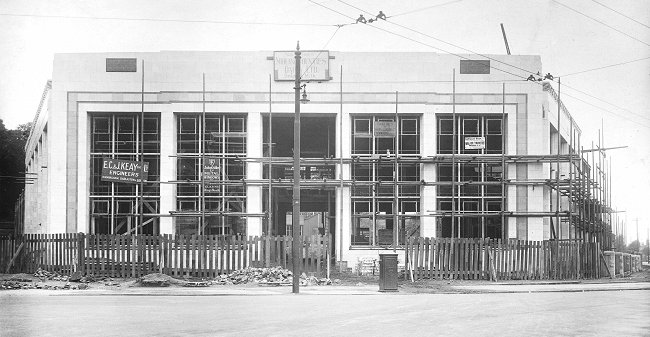
Keays provided the structural
steelwork for the Midland Counties Dairy on the corner
of Lea Road, Wolverhampton. Built in 1930/31. |
| In 1935 the company was wound-up and reformed as
a private limited company: E. C. & J. Keay Limited. |
|
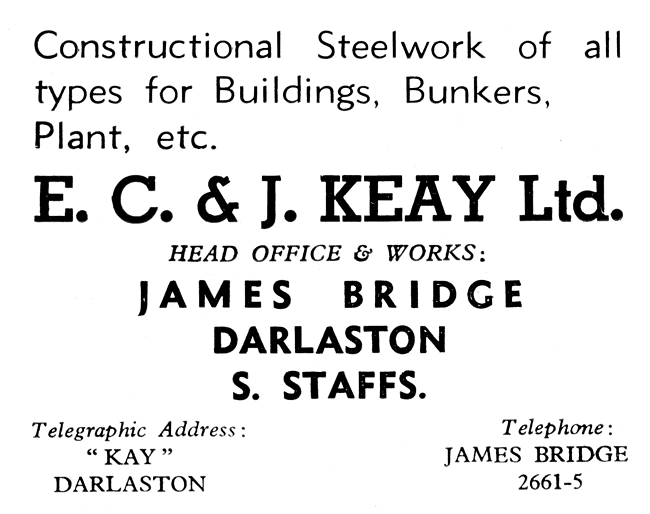
An advert from 1963. |
 |
The firm provided the steelwork for Birmingham Snow
Hill railway station, which consisted of 6,000 tons of
steel, transported to the site on the firm's Pollen
railway girder wagons. Keays also supplied 1,000 tons of
steelwork for Leicester railway station, the cast iron
pillars used in Kensington High Street Underground
Station, and the steelwork for Neachells No.1 and No.2
power stations, the latter using 8,000 tons of steel.
|
| Other contracts included the Great
Western Hotel at Paddington; Llandudno Railway
Station; large sheds at Southampton Docks; the first
aeroplane hanger at Elmdon; Walsall Technical College;
Typhoo Tea Buildings and Warehouse; Offices at
Birmingham; Midland Counties Dairy at Wolverhampton;
and McKechnie Brothers factory at Aldridge. The firm built many bridges
including Norfolk Bridge at Shoreham-by-Sea; hoppers;
bunkers; railway signalling equipment; the fencing and
gates for Willenhall Memorial Park; also bus depots; and
carried out riveted platework, and welded fabrications.
Structural steelwork was also supplied for building
projects abroad.
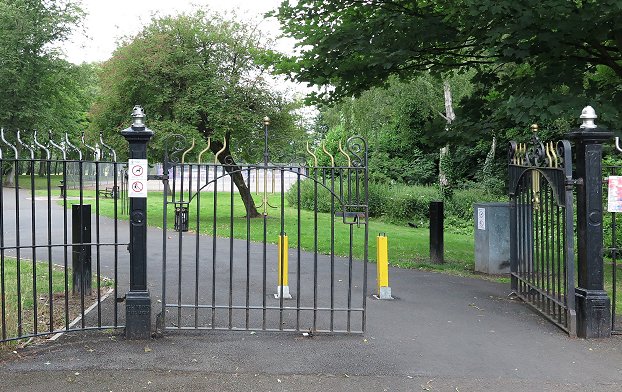
The gates and fencing at
Willenhall Memorial Park.
In 1957 Keays became a subsidiary
of N. Hingley and Sons, Limited, and in November 1960,
part of the Lloyds Group. On 12th August 1969 F. H.
Lloyds became part of F. H. Lloyd Holdings Limited.
In 1972 the Directors decided to
restructure the company to bring about more effective
coordination of marketing programmes, production
techniques, research technology, and to improve
inter-company communications. In order to achieve this
the companies were grouped into three divisions;
engineering, foundry, and steel. The restructuring was
announced in December 1972 by Mr. M. C. Lloyd. Keays
became part of the Engineering Division. |
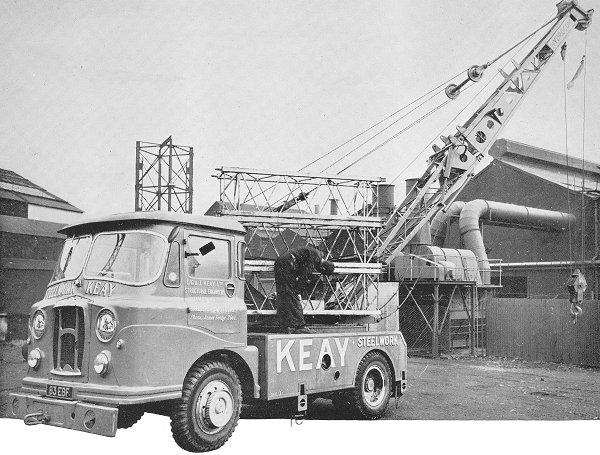 Keay's 'Hydrocon Highlander' 6 ton mobile
crane, acquired in 1962.
Keay's 'Hydrocon Highlander' 6 ton mobile
crane, acquired in 1962.
| 1962 saw the installation of a
54 inch Noble and Lund vertical cold circular sawing
machine, which could cope with the largest sections of
the company's new universal beam range.
It could vertically cut steel
joists of up to 40 inches by 18 inches, at any angle. |
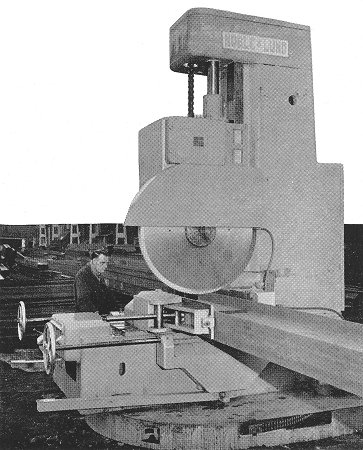 |
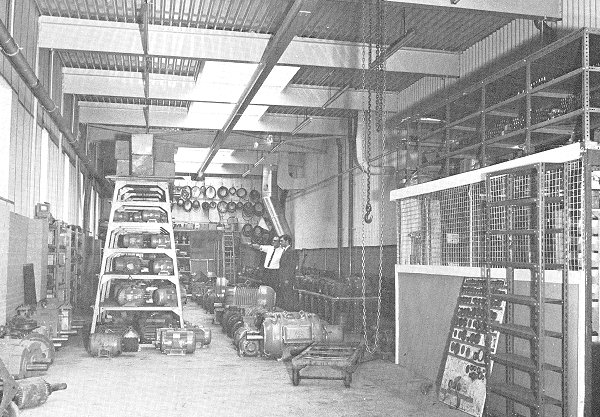
In 1971 Keays designed and built
the new 3,600 square feet storage bay and works canteen
for fellow Lloyds Group member, The Mechanical &
Electrical Engineering Company (Walsall) Limited. |
 |
|
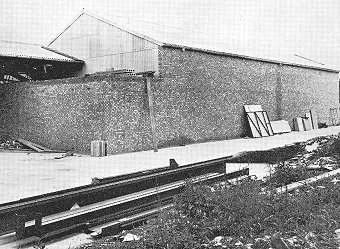 |
| A small,
but relatively complex installation took place
in 1971 at George Johnson & Company (Birmingham)
Limited in Shirley. The new building had to be
erected over the top of an existing building
that had to remain in use during the building
work, in order to maintain production. When the
new building had been completed, as seen on the
right, the existing building was demolished.
|
|
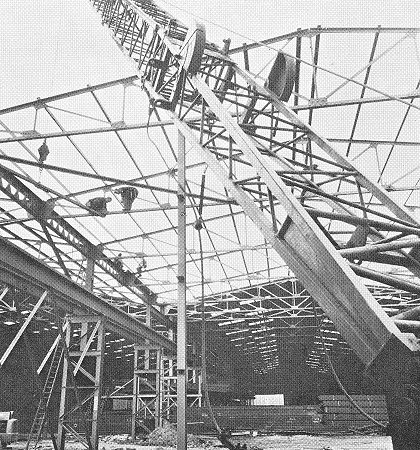 |
The erection of a two-bay
warehouse at Wednesbury in 1971 for Brinton, Adams &
Richards Limited. |
| Another view of the warehouse
during construction. |
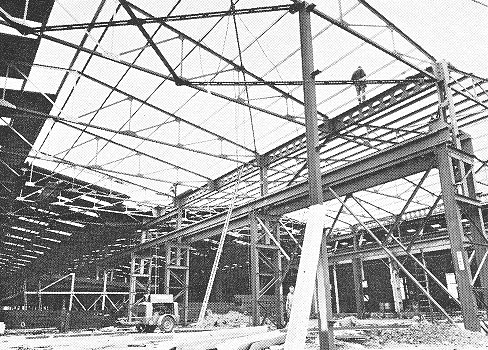 |
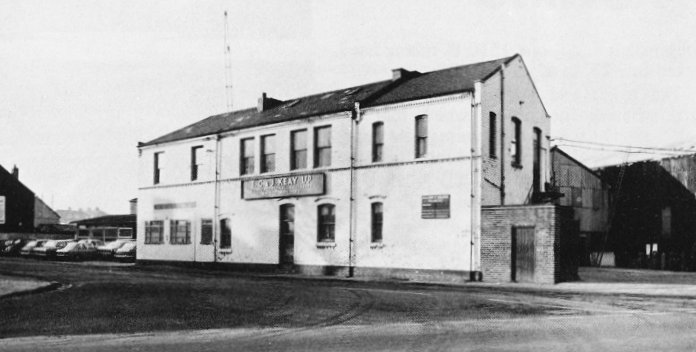
The old office building in
Station Street Darlaston, which was demolished in
1973. Courtesy of Wendy Marston. |
|
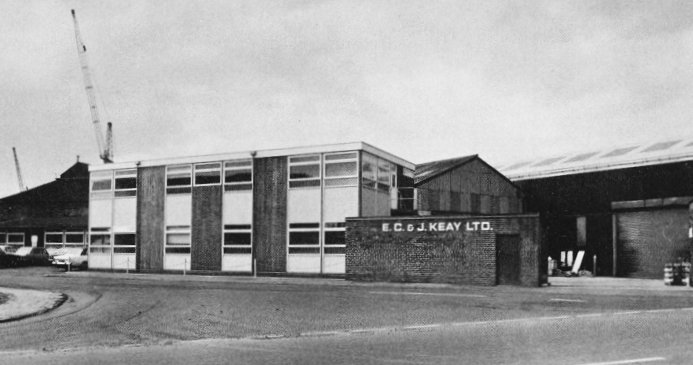
The new main office building
in Station Street, built in 1973 following the
demolition of the old offices. Courtesy of Wendy Marston. |
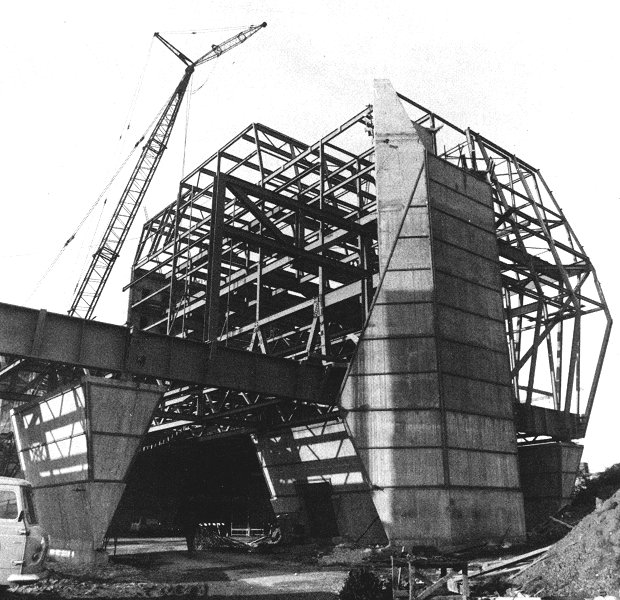 |
Another Keay project, the
steelwork for the Coventry sports complex building.
A contract worth £185,000.
Courtesy of Wendy Marston. |
|
Some of Keay’s projects in the
1970s included the building of the steelwork for a
number of Littlewoods stores, including ones at
Norwich, Harrow, Lewisham, Truro, West Bromwich,
Worcester, Kidderminster and Corby. Other projects
include steelwork for the following:
The Incinerator
Building at City of Stoke-on-Trent.
A number of 200
ft. high flare towers for North Sea oil rigs.
Manchester
United Football Club including some large Cantilever
girders.
A continuous
casting platform for Round Oak Steelworks.
In 1975 the company installed a
computer to provide "instant designs" of portal
frame structures. A special program was written to enable Keays to increase their activities
in the supplying of supporting structures for water
tanks made by Brown Lenox (London). |
| In 1975 Keays built a new roof
covering one of the stands at Manchester United's football
ground, Trafford Park. It involved nine 160 ft. long lattice
girders, each weighing nine tons. |
 |
|
In 1977 a reorganisation scheme
began at James Bridge to create larger production
areas, improve the overall efficiency of the plant,
and provide better working conditions. As a result,
Keay’s factory ceased to be used for structural
steelwork, and became Lloyd’s Pattern Shop. |
 |
Return to
the
previous page |
|



